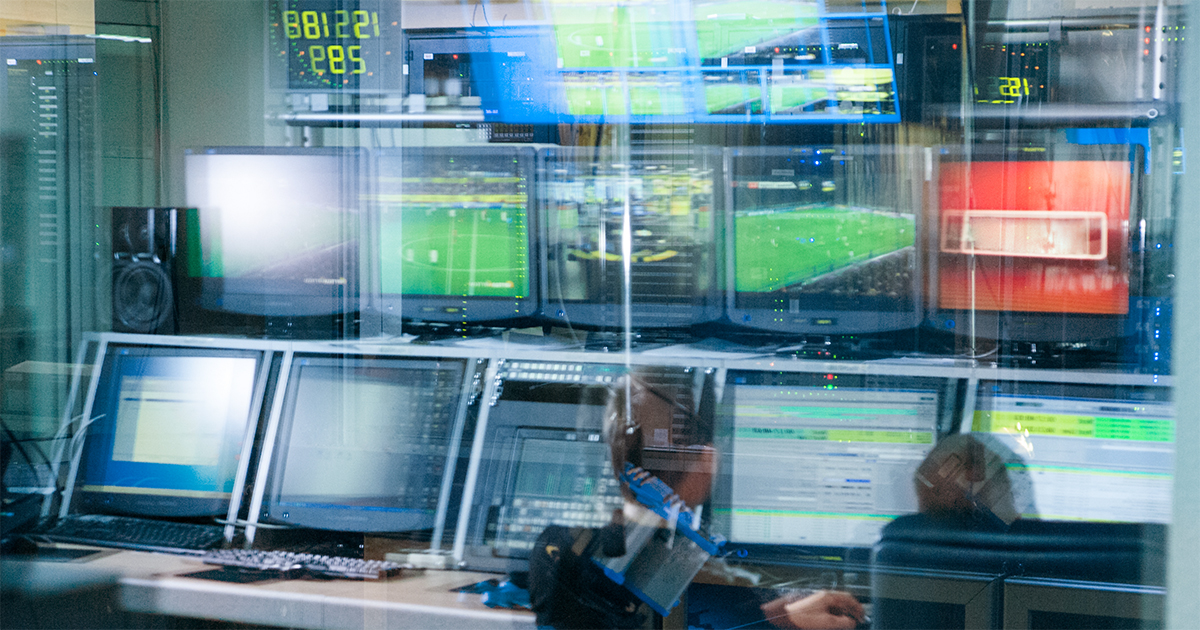
Presented by Imagine Communications
Sports are no stranger to storytelling. That is true whether it is a pick-up game with only campfire tales to tell, or live multi-venue Olympic competition with its highly produced narratives. The energy and excitement emanate from the field, but what drives fan engagement is a compelling story.
Maybe it’s just a cell phone camera streaming live to social media, but the stories are easier to share than ever. Many productions, once dependent on purpose-built hardware, now have virtualized software doing much of the work. Remote workflows, needed more over the past year than ever before, now benefit from the flexibility of IT and COTS technologies.
And it has some of us asking, “Why did we ever do things the old way?”
Winning at Home and Away
As viewers, we want to focus on our favourite athletes, demanding custom views with more cameras and additional metadata. Viewer-controlled replays are no longer enough.
The SMPTE ST 2110 family of IP standards defines methods of routing all the audio, video and data, which opens up the opportunity to do much more. An object-tracking 360-degree camera with ST 2110 low-latency outputs can be placed almost anywhere and deliver engaging, informing pictures over any distance, synchronized with the rest of the coverage and with excellent picture quality. We aren’t limited to 16 audio channels per video stream, either.
Using a powerful computer server as the host, or an FPGA, production teams can assemble a stack of processing resources and then dynamically assign virtualized software components to achieve what is needed in the moment. This virtualization allows for easy upgrade paths and avoids fork-lift replacements of hardware.
Dramatic changes in system functionality and configuration can be saved as scripted, pre-set recalls to match the unique requirements of each event. When an operator or engineer can press a few buttons to change the entire router database, multiviewer system and processing paths, the patch bay fades into history.
Remote workflows have always been a part of the game ― from that single reporter with a handheld camera to fly-packs supporting a live production. The ability to move live video over the public internet has been expanding the reach of the broadcast industry for years. But when the global pandemic changed everything about live events, the ability to access and operate production equipment via the internet became mandatory.
We have all been forced out of our comfort zones over the past year. Many people who had been operating physical control panels in a control room are now masters of the touchscreen, producing live events from browser-based interfaces. The familiar positions remain for big multi-camera shows ― audio, graphics, technical director, and so on ― but now operating from HTML5 soft panels.
This new generation of technology means we can cover traditional events in new ways, with remote, socially distanced production. It also means we can cover more events ― the smaller shows, rarely covered in the past ― from a single tablet. This is all proven technology. We just finally realize its value.
Your Very Own Sports Network
Those same technologies allow everyone to become their own content originator. Live production and broadcast of multi-venue competitions was once purely the domain of media giants. Now colleges are using dark fiber, the internet and social media to provide elaborate campus-wide coverage directly to the fans. Sport is no longer dependent on the networks. It is live on any streaming app a teenager can connect their phone to.
Those of us already in the business can unleash our imaginations as well. While the aspiring camera operator with a phone expands our reach, the professionals can push the limits of the media. A few rack units of COTS switches can support large matrices, thousands squared, of UHD and high frame rate streams. SMPTE ST 2110 allows systems to start small and grow one step at a time, to 8K and beyond.
When optimized, the density per rack unit of a COTS IP switch (480 x 480 of 1080p) and power consumption per video stream (less than 2 watts for an HD stream) cannot be matched by SDI solutions. Trucks have realized these advantages for years, supporting UHD, HDR, and high frame rate. VR media and 8K can move through the same equipment.
The owners of massive data centers, offering cloud services, are also making it easier for us to work with them. The latest codecs and formats, like JPEG XS, allow live UHD and HDR media to move in and out of that realm. Cloud services providers are improving the latency in and out by the millisecond, enabling highly reactive, cloud-based production-to-playout workflows.
Real-world applications have demonstrated these technologies are ready and relevant. For example, we recently provided Sinclair’s Tennis Channel with core infrastructure for a large-scale ST 2110 production center and a cloud-based environment for pop-up live events, which Sinclair used to spin up live channels covering the 2021 Miami Open tennis tournament in March. All the playout, including the unpredictable live interventions associated with fitting commercial breaks into tennis matches, was hosted in the cloud, with operators sitting wherever was convenient and safe for them. They used the same platform for coverage of the 2021 French Open from Roland Garros.
Tying it All Together
The future, then, is thousands of video streams within one big router, across multiple venues, separated by kilometers, carried over whatever circuit is convenient ― including the public internet.
Consider massive events such as the Olympics or World Cup. HD and UHD cameras abound. Fans watch live coverage with tailored data and commentary via their television, computer or phone. Broadcast technology on IT platforms brings everything together and places all media sources and destinations at the fingertips of sports production teams.
Electronic gaming and fantasy sports inspire leagues, content producers, networks and online services to add more metadata with each event, including interfaces to analytics and artificial intelligence engines. ST 2110 and virtual routing control systems can transport this data and bring all content together at the ABR distribution encoders. Consumers can now receive their content by their desired method, in their native language, on the device or platform of their choice.
There’s nothing to fear in moving beyond “the old way.” The technology is here today. The camera, a cell phone or a drone can be almost anywhere to capture the right angle. The video signal can move, with or without a wire, to almost any viewer. Production can be executed miles away from the production equipment.
For years we’ve been recreating old workflows on new tech. The next step is to change our mindset. Next year will bring more powerful hardware, but the real advances will come from the human side of the workflow ― with bold choices by production teams leading to a new era of great sport stories.



